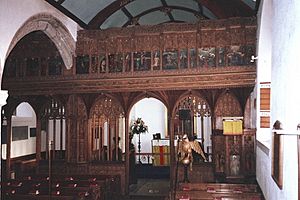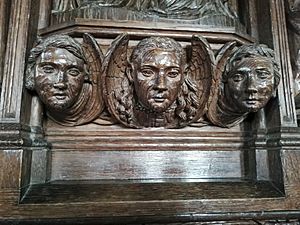Pinwill sisters facts for kids
The Pinwill sisters—Mary (1871–1962), Ethel (1872–1951), and Violet (1874–1957)—were amazing artists from Devon, England. They were professional woodcarvers who created beautiful decorations for churches.
In the late 1800s, woodcarving for churches was a job almost always done by men. But the Pinwill sisters were not only incredibly skilled at it, they also started their own successful business. Their workshop created amazing carvings for over 60 years. They decorated more than 180 churches in Devon, Cornwall, and other parts of England. Their work is still admired today for its great skill and beauty.
Contents
How the Sisters Learned to Carve
Mary, Ethel, and Violet were three of seven daughters. Their father, Edmund Pinwill, was the vicar (a type of priest) at a church in Ermington, a village in Devon. Their mother, Elizabeth, was a musician who played the church organ. The girls were taught at home by governesses.
Their journey into woodcarving began when their father's church was being restored. The architect in charge, E. H. Sedding, became a good friend of the family. Their mother had a brilliant idea. She asked the head of the carving team working on the church to teach her daughters in the evenings.
A workshop was set up for them in a room above the stables. Using tools and books that belonged to their grandfather, who had also been a carver, the girls began to learn. At that time, it was common for young women to learn skills like drawing or sewing. But their mother encouraged them to turn carving into a real profession. Mary, Ethel, and Violet loved it and quickly became experts.
Starting Their Own Business
The sisters' talent was clear from the start. In 1889, they carved a beautiful pulpit (a raised platform where a priest preaches) for their father's church in Ermington. People loved it! Their work received fantastic reviews, which encouraged them to take their skills further.
In 1890, the sisters decided to start their own professional business. They opened a workshop in the nearby city of Plymouth. They called their company Rashleigh, Pinwill and Co. Rashleigh was a family name, and they used it to help hide the fact that the business was run by women. At the time, it was very unusual for women to have a company like this. The name worked so well that even today, some church guides mistakenly refer to their work as being made by "Messrs. Rashleigh and Pinwill," thinking it was two men!
Working with an Architect
The architect E. H. Sedding was a huge supporter of the sisters. He often designed projects for churches and then hired the Pinwill workshop to do the carving. Together, they worked on many churches, creating everything from large screens to small details on benches.
One of their most famous collaborations was at St Carantoc's Church, Crantock in Cornwall. They helped transform the church from a near-ruin into a beautiful place of worship. Their work included pulpits, altar rails, and detailed bench ends.
Running the Workshop Through Challenges
The business changed over the years as the sisters' lives changed. They also faced difficult times, including two world wars, but their workshop survived for decades.
A Change in the Family
In 1900, Mary got married. In those days, it was expected that a woman from her social class would stop working after marriage, so she left the business. Ethel and Violet carried on together. Violet moved to Plymouth to manage the main workshop. She also began teaching woodcarving to men and boys at a local art school.
A few years later, Ethel moved to Surrey, near London, and started her own woodcarving business there. This left Violet in charge of the original company in Plymouth.
Violet Takes the Lead
Violet proved to be an excellent businesswoman and artist. She renamed the company to V. Pinwill, Carver. By 1914, her workshop was so successful that she employed 29 men and boys as carvers and joiners.
However, when World War I began in 1914, many of her skilled workers were called to fight in the war. With fewer people to do the work and fewer new projects, Violet had to close the workshop for a while. After the war, she reopened and began creating beautiful memorials to honor those who had died.
Surviving Hard Times
The years between the wars were difficult because many people had less money to spend on church decorations. Then, in 1921, their great supporter, the architect E. H. Sedding, passed away. By this time, however, Violet was a skilled designer in her own right and continued to create amazing pieces.
When World War II started, the workshop faced similar challenges as before. But Violet kept the business going. She continued to work on large projects into the 1950s and was still carving just days before her death in 1957, at the age of 82.
The Lasting Legacy of the Pinwill Sisters
After Violet died, the workshop was closed for good. All of her tools, plans, and designs were sold or destroyed. Sadly, many of the sisters' carvings in Plymouth were lost when the city was heavily bombed during World War II.
Despite these losses, the incredible work of the Pinwill sisters can still be seen today. There are at least 168 churches in Devon and Cornwall that have their beautiful wood carvings. In total, about 650 of their individual creations have survived.
The Pinwill sisters were true pioneers. They broke into a field dominated by men and created a business that produced some of the finest church art in the West of England. As one expert, Peter Beacham, wrote, their work "delight[s] the eye and make[s] the spirit soar."






